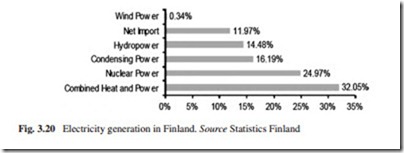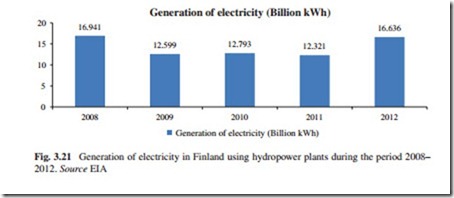Finland
Although the construction of hydropower in Finland started with the turn of the century, the main increase of capacity took place in the 1950s and 1960s when the share of hydropower of the country’s electricity generation reached 90 %. In 2012, the total hydropower capacity installed in Finland was 3,171 MW, which generated 13 TWh of electricity generation. The goal of the Finland government is to generate 3 TWh more using hydropower plants by the year 2025 in order to generate 16 TWh; this represents an increase of 9.5 % with respect to the level reached today. The hydropower capacity installed in the country in 2012 represents 18.58 % of the total capacity installed. With respect to renewables, the hydropower capacity installed represents 57.52 % of the total.
Finland occupies the place number 38 at world level, according to its hydro- power capacity installed (0.33 % of the world total). Within the European region, the country occupies the place number 12 (1.88 % of the total regional hydro- power capacity installed). In the past ten years, the average annual increase in hydropower growth was 0.67 % and occurred in nine years within that period.
The objectives of the Finnish energy policy are the following:
• Security of supply;
• Effective energy markets and economy;
• Environmental acceptability and safety.
In Finland, energy supply decisions on energy systems take place at a fairly decentralized level—with the exception of nuclear power. A substantial proportion of the energy used in the country is imported and produced by private enterprises. The energy companies with majority ownership by the State are also run on a purely commercial basis.
According to the study made by the ministry of Trade and Industry in 2005, there is still 663 MW hydro potential left in the already constructed and unprotected watercourses. There is another 1,467 MWe of new hydro potential in the protected watercourses, so the techno-economic hydropower potential in Finland is altogether 2.130 MW. In terms of annual energy production, it equals less than 10 TWh of electricity production. The increase of this potential can be achieved by upgrading and construction of auxiliary machineries in connection with refurbishment projects. Also, the aging hydropower plants have been refurbished in order to achieve a 40 % increase in the total capacity installed. It is important to high- light that since 1990 the capacity of existing hydropower plants has increased by almost 130 MW, mainly due to upgrading carried out in connection with refurbishment projects. Undoubtedly, upgrading made in connection with the refurbishment of existing hydropower plants operating in the country is the most advantageous way to increase hydro potential. Some increase—but limited—can be achieved by the construction of new hydropower plants and auxiliary machineries. The annual amount of diversion energy—due to inadequate storage capacity—is approxi- mately 750 GWh, of which only 7 GWh is included in the above-mentioned increase plans.
The construction of new hydropower plants has been greatly restricted by the Costumer Protection Act of 1987 and other nature conservation acts and measures.
There are 207 hydropower plants operating in Finland today, including 67 micro-hydropower plants (generating less than 1 MW), 83 small hydropower plants (1–10 MW),19 and 57 large hydropower plants (generating more than 10 MW).
Hydropower plants are highly cost-effective investments due to their long use- ful life. The capital investments made in older hydropower plants have already been amortized, leaving only running and maintenance costs. Since the year 1970, only 5 MW of hydropower capacity has disappeared.
The environmental impacts of hydropower plants are largely local in scale. Dams inevitably alter the hydrological conditions along the harnessed water course, due to the regulation of water levels. The flora and fauna of any land areas submerged under new reservoirs will be lost or forced to relocate. The same is true for any people whose homes are located in such areas, who may need to be rehoused. There is also a risk that any harmful substances such as heavy metals present in soils submerged under reservoirs will leach into the water and accumulate in fish and other creatures. Carbon dioxide and methane may also be emit- ted into the atmosphere from submerged areas, especially if trees are not removed. Such emissions are a greater problem in tropical regions than cooler, temperate zones, however. Hydropower production does not itself generate any greenhouse gases, so increases in hydropower capacity are favorable in terms of mitigating cli- mate change if they enable reductions in the use of fossil fuels.
Hydropower Electricity Generation
One year after the publication of the Climate and Energy Strategy, the Ministry of Employment and Statistic published in November 2009 a new report, which con- cluded that electricity consumption has settled into a lower than expected growth trend, due to the economic recession, structural change in the forest industry, and the intensely growing efficiency of electricity consumption in households and services.
Finland’s climate and energy strategy of 2008 projected a consumption figure of 98 TWh as the objective for 2020. According to the new estimate presenting late 2009, electricity consumption in 2030 was estimated by the Ministry to total some 100 TWh; this represents an increase of 2 %.
The goal of the Finland’s Energy Strategy of 2008 report (updated in 2013), presented by the government to the parliament, is to increase the share of renewable energy to 38 % by 2020, in line with the obligation proposed by the EC for Finland. This is a challenging obligation, and its attainment depends on having final energy consumption enter a downward trend. The 2008 climate and energy strategy set the energy savings target at 37 TWh (as calculated from final consumption) by 2020. Electrical energy accounted for 5 TWh of this target, and thermal energy and transport fuels for the rest. Final energy consumption would then amount to 310 TWh in 2020. With respect to electricity, this goal will be met primarily due to slower economic growth and structural changes in the economy. As regards other forms of energy, this target may not be met, in which case the final consumption target of 310 TWh will not be fully achieved. This is partly due to a change in statistical methods, which corrected the earlier underestimation of the historical energy consumption, which was used as the basis for the preparation of the 2008 strategy.
Finland’s natural resources would facilitate the additional use of renewable energy, but in order to realize this, the current subsidy and steering systems must be rendered more effective and structures changed.
According to Fig. 3.20, the share participation of hydropower plants in the generation of electricity in Finland is 14.48 %.
The main sources of power production in Finland are thermal, nuclear, and hydropower plants. So far, only a very small volume (about 0.34 %) of electricity is produced by wind power, although the relative increase of wind power capacity has recently been quite rapid. Finland’s electricity generation capacity (nominal) totaled at the beginning of 2010 about 16,600 MW. In addition to the production of electricity in the country, electricity is imported from Russia, the Nordic electricity market, and Estonia.
The evolution of the generation of electricity in Finland using hydropower plants during the period 2008–2012 is shown in Fig. 3.21.
According to Fig. 3.21, the generation of electricity in Finland using hydro- power plants during the period 2008–2011 decreased significantly (27.3 %). However, during the period 2011–2012, the generation of electricity using hydro- power plants increased 35 %. Considering the whole period 2008–2012, the generation of electricity using hydropower plants decreased 1.9 %. It is expected that the role of hydropower plans in the generation of electricity in Finland continues to be similar to the level reached in 2012, which is almost the same that the level reached in 2008, at least during the coming years.

